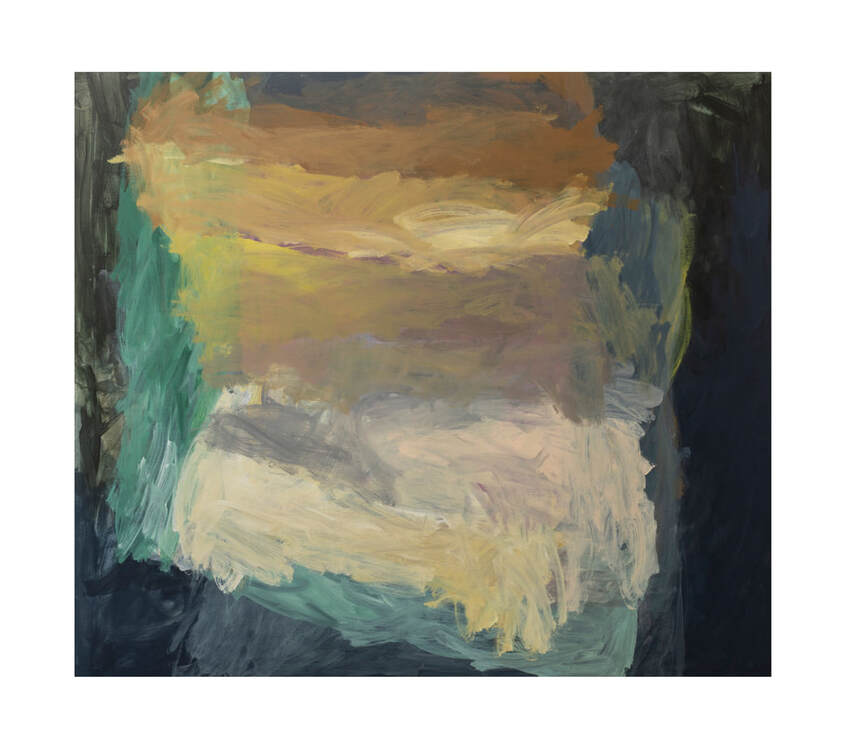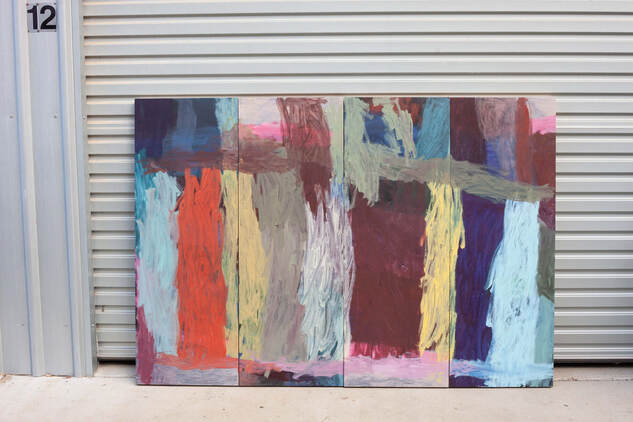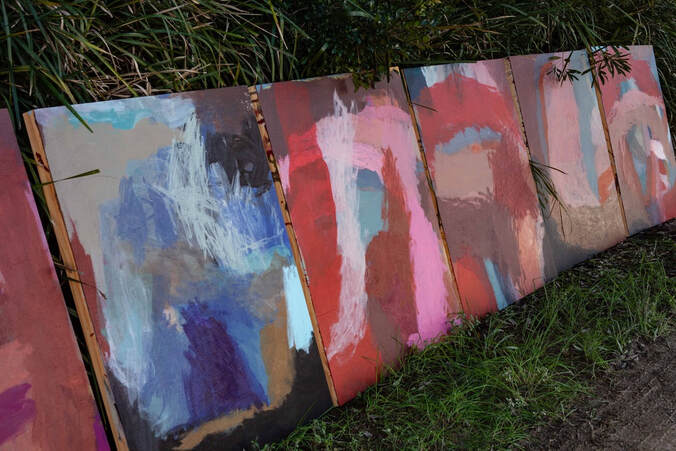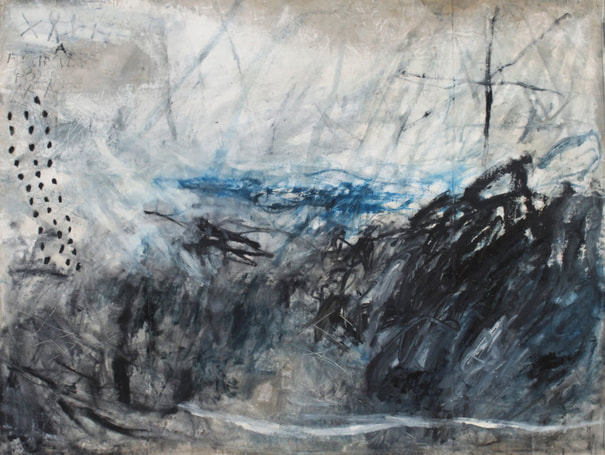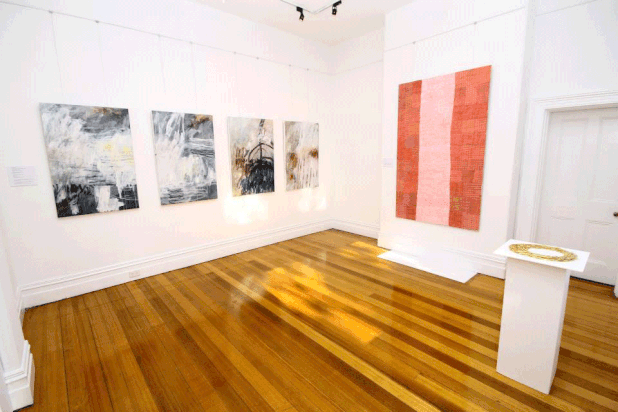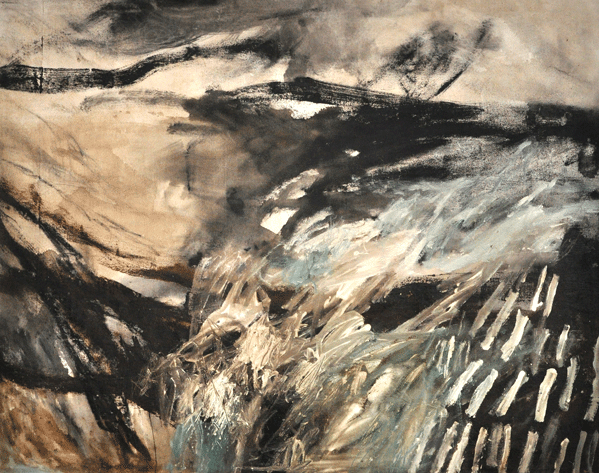ARTICLES |
|
|
|
|
The last time I wrote on Davidson’s practice, the paintings had come out of a period of turmoil and chaos, a house of cards collapsed, the cards and everything else around were soaked through. There was great personal loss, devastation from floods and a means to connect to family heritage and trace a personal lineage. The paintings in this series continue to act as portals, a means to balance her pendulum. This series pulls you into places that run the spectrum from the calm to the devastated. It is powerful and rich, packed with raw emotion expressed through rhythmic gesture. There is a harmony on the surface that comes with Davidson’s confidence to soften the pieces through translucence. Their depths are open and endless, sometimes allowing the viewer in through compositional structures that pull you to the centre. There are also pieces that explode out to the edge and keep the eye bouncing from corner to corner. They express spaces, rooms and places to explore. The surfaces are loaded, but balanced and they continue to image memory and dreamscape. These scenes infuse themselves into the work with a connection to the wild and landscape. The physical landscape in relation to the psychological is very much at the core. Davidson continues to channel her immediate surrounds and the broader contemporary issues of our times through her brush. The timber board exists as a safe space for Davidson to reflect on and navigate the issues of daily life. Its rigidity allowing for the frenetic gestures, holding up as a firm support to the catharsis.
The light creeps up and in, through the blinds, under the door. The day inviting itself into the room, waking the slumber and giving form to our surrounding. There is an expression of spaces, places and forms in these paintings. It could be a cave, a shed, or a glass box as well as a creek bed, valley or mountain, but what is important is the softening of form. The definition is blurred, contorted but full of life. Light bouncing around, reflected and refracted, absorbed and dealt. Visual phenomena and effects of light are critical in the development of this series of work. Waking from the dream and attempting to piece the shattered visual back together, opening your eyes and stumbling with the initial blur. ‘Phosphene’, 2023 alludes to the visual stimuli created when closing your eyes tightly and applying pressure to the eye. The swirls and zig zags dance around until the retina settles. The yellow suggestive of a gaze into the sun and the resulting dizzying spell. It is a work that pushes and pulls the eye, you trace its passages and forms around the boards, up and over its minor plywood ridging. This movement definitely brings to mind the eye attempting to regain focus, to shake the spots and swirls out and to find resolution. ‘Luminol’, 2023 refers to another phenomenon based in science and more specifically forensic investigation. Luminol being an organic compound that is used to detect blood splatter in crime scenes. The substances will emit light when oxidised, often activated under blue light. Davidson has waved her brush up and over her dark scene, blue light providing another element to the scene, a pronounced dark drip from the upper section to the top edge. All of these paintings question how we relate to light, how it allows us to understand forms, shapes, spaces, and colour. Davidson looking for it in every scene, dealing it out through her translucency and searching for it in her depths. Davidson finds comfort in her abstraction and looks to the past in works by the great Joan Mitchell, Helen Frankenthaler and most certainly Mark Rothko. A contemporary would perhaps be the large paintings by Columbian born Oscar Murillo who shares a similar frenzied approach to mark. His manifestation and news series have a direct correlation with how Davidson works in terms of the absorption of mass media, social, political and economic streams feeding into the mind and memory. A battlefield of power and psychological landscape present in both artists raw and at times aggressive gesture. The layers reveal themselves with time and for Murillo it is also about balancing the nature of the mark and surface with the complexities of the world around. The trace of labor and worked surfaces clearly evident in Davidson’s painting. There are many similarities but none more evident than the signing of the body. I look into these paintings of Davidson, they both calm and excite depending on the piece, but in all cases there is a suggestion of the exhausted body, labor and hand. Everything put on the line and left out and open for the viewer. The raw and wild. Freedom at the precipice. ‘Night Jacaranda’, 2023 hints at a mysticism and the unknown. There is a part of Davidson’s practice that is in many ways about connecting on another level, a little shamanic, portals to spirit worlds, searching for light through the darkness. There, one can find hope in the light. It is this more grand and optimistic motif that is brought back down to earth through reflections on the everyday. Davidson states; “Things like, plants, landscape, home, washing, working, driving, clouds, seasons and normal daily cycles of activity. The paintings weave a variety of themes together taken from many threads, and like a rainbow, reflect the multiple parts of the colour spectrum in varied configurations and compositions.” The mundane pulls equally with that of the fantastical, gateways as fields of immersion to explore but painting very much in its surface, material and gesture. The painter as gatekeeper, conjuror of colour and light, brushes abstracting the headlines of the day with a dream of night before. In the last series there was a connection with a Viking heritage, a sense of adventure continues here but an equilibrium achieved through finding value and importance in the simplicities of the home. The first light as the sun creeps up and illumination spills out over the land. Form is found and colour starts to register itself. The darkness forgotten and focus gained. The morning news is digested with breakfast and then melded with a dream or memory into a gestural mark. Life emits itself out of these paintings with a raw and powerful presence. Thinking about the previous shows in relation to this series it is a focus on balance and harmony that fuels Davidson’s abstraction. ‘Spectrum’ here, by definition, could be applied in any number of ways. Davidson’s rainbow banding of colour, the classification of her varying inputs from the calm to the chaotic but also the notion of a range of objects, ideas or opinions. The paintings infuse an all encompassing stimuli through the active body, the surface holding an awesome power but balanced with sensitivity. James Kerr, 2024 |
|
|
All afternoon it rained,
then such power came down from the clouds on a yellow thread, as authoritative as God is supposed to be. When it hit the tree, her body opened forever.’ - RAIN by Mary Oliver. This exhibition is dedicated to the memory of my brother who passed on 1st March 2022 during the apocalyptic floods in the Northern Rivers. - Imbi Davidson House of Cards is a show that deals with tragedy and loss, chaotic natural disaster and the uncertainties brought on when tackling such turmoil. Despite the difficulties faced by the artist, we see paintings bursting with colour and vibrance, surfaces that seem to act like portals or passageways to calmer and more stable footing. These paintings posses a frenzy of marks, intuitive gestures loaded with passion but composition and colour brought together with great control and consideration. The paintings are a way for the artist to navigate rough seas and find comfort in connecting to her heritage. Davidson’s studio is based on the coastal edge of the Northern Rivers region of New South Wales. This area has seen devastating flooding and destruction. The day the flood hit the region Davidson also suffered the tragic loss of her brother due to complications from haemophilia, a genetic blood disorder carried by the male lineage of her family. These paintings come intuitively, they are a means of connection to her heritage with a tender touch. They mourn and speak to loss and chaos but move us forward, through and away from it. The compositions have found more structure, not rigid but perhaps soft gateways to move through. The work ‘Steps to Valhalla I-IV’, 2022 is a painting across four panels that as its title suggests is representative of Davidson’s Viking heritage but more importantly is a piece in memoriam of the passing of her brother. Valhalla or the ‘hall of the fallen’ is said to host an afterlife that was the envy of any Viking warrior. Here the fallen are able to continue their battles of valour and then be healed to enjoy feasts of the evening. I see the piece as a ‘memento mori’ but more importantly as a visual feast and celebration of Davidson’s connection to her brother and her family. The paintings in this show are a channeling of emotional strain as a means to process this loss. Davidson states; "The studio has been a singular, solo site of personal solace, as our town, region and family come to terms with such devastation and grief. The act of painting in such times has been tough, uncomfortable and at times challenging. I almost gave up. These works speak to that place of vulnerability that feels as shaky as a house of cards. The feeling that at any minute the world might break, the land move or crumble, reminding us of our inherent fragility in the face of life.” Despite the raw emotion and energy of mark we find a very bright and uplifting palette in this show. Ironically a little less muddy without the browns of the previous show. Here these works feel fresh and bright. Pathways, steps, windows of light woven together with control of translucent and opaque passages in the compositions. The paintings are still wild and free but they are somehow softer and maybe more open while also continuing the use of what the artist states as recycled paint as her material. This is an ongoing constraint or implied control that sets a cohesion across the series. Here we see a slightly higher key of colour and with reds and intermingling blues reminding us of the shows impetus. Writing about this show feels a little strange, the artist is unable to attend once again due to the chaos and uncertainty in the world. I look at the works and am reminded of Davidson’s positivity. The vibrancy and marks are so appealing and full to the brim with calligraphic energy. This show feels like the Viking boat is clearing the treacherous stormy seas and coming into port in the sun, ready to feast in the great halls with family and friends. I feel so proud to present a show that has such soul and power, paintings that say something about living through hard times, testing experiences and taking them on the chin and getting on with it. I have seen strength of character in all that Davidson has faced over the last year and see a wonderful authenticity in the painting. These marks are coming from somewhere deep down, they are a way through all the devastation, a way to hold the hands of her ancestors and to sing in memory of those lost. It is distinctive in mark, celebratory in colour and gesture but most importantly these works have come out of struggle and pain, mud and blood, but push us forward and remind us that the seas will settle. I was blown away by Imbi Davidson’s first show at the gallery last year and I have been caught in the swell of emotion in this room. This is great painting in so many ways but these works needed to be painted, the swirls and push and pull on the surfaces tell a great story of survival and perseverance. |
In The Wind
|
Mailbags from the very edge.
|
|
A detail from Imbi Davidson's 2009 work Incognita. Source: Supplied
THE word spread slowly, insistently, during the height of the build-up season in 2009, when Northern Territory gallerist Dallas Gold staged the first solo show for a young, unknown Darwin artist with a strong expressionist lean to her work. In those humid weeks, with dark storm clouds reaching skywards and maddened fruit-doves crying out their mating calls, almost anything can appear feasible. And so the first reports of the suite of paintings by Imbi Davidson on view at Raft Artspace - vast, rich-hued paintings, made on canvas from old mail bags - seemed to fit perfectly with the temper of the time. The paintings were lush, exorbitant and unconstrained. Deep veils of black and Prussian blue, scored with lines and stencil-marks, with symbols and letters cut almost through the fabric: this was an art unlike anything seen in the northern capital, yet it was instantly recognisable as the product of the tropics and their shimmering, intensifying light. Lost at Sea, the set of mail bag canvases was titled: the images evoked the experiences of mariners, sailing on turbulent oceans towards the southern continent, but they were also imbued with the hazy textures of monsoonal skies. The first collector to see the works on the gallery walls snapped up the entire show. Gold moved his Raft Artspace from Darwin to Alice Springs mid-way through 2010 knowing he had fulfilled his desire to uncover a great original among the ranks of non-indigenous artists active in the north. "Each one of those works was like a night ocean journey in itself," he says. "Imbi's canvases take you into a strange space, you go on a voyage of your own deep into the paint." Just past 30, Davidson came north more than a decade ago and spent some years living on a Yolngu clan homeland outside remote Ramingining, on the margins of the Arafura swamp. She engaged in protracted university art studies while based in Darwin, but her real teacher was the landscape: it bore in on her, and shaped her. Her environs seem reflected in every canvas she makes. After her 2009 Raft show, Davidson embarked on a year of travel: India, Canada. She produced a stream of distinctive works. There were drawings based on botanical sketches, turbulent skyscapes, hectic panoramic views, thick with lines, arcs and hatchings. They had the feel of views from high in the air and mingled, in novel relationships, blues, whites, deep reds and burnt shades of earth. Pieces from this series, Tar and Feather, go on view in May at the new Chan Building gallery in central Darwin, as part of a three-artist show. That exhibition will also mark a hinge-point in Davidson's life. For, after so long living in the Territory, and so long studying the Top End's landscapes and their effects on the imagination, her northern phase is done. In a recent entry in her episodic website diary, she reflected on the effect of constant exposure to the landscape. "Even in its gritty bloodthirsty intensity," she wrote, "there is on this edge of the world a glory, a splendour and untamed harshness." In person, Davidson is contained, almost self-effacing. Unlike most university-trained contemporary artists, she has no easy words to accompany her paintings. Works more expressive of an individual tilt on the world are hard to imagine. In discussion, she sets out the elements of ordeal and struggle that hold centre stage in her art-making. She speaks of the importance of wounds and scarification-marks in the Aboriginal world she came to know in Arnhem Land. Scars, and healing, and recovery from the blows of life: these are the ideas uppermost in her thoughts. Art in the north involves battle, survival and a resultant insight: "I see here a sharpness in the art, an edginess: being able to speak the language of the bush is essential, feeling the bones of the country, seeing them and tracing them." And the artist in such country has a specific task: to find a means of conveying ideas and impressions that lie beyond easy understanding and the simple reference frames of our experience. "There are things in artworks that provoke thought, but that we don't have words for," she says. "Isn't that our part, as artists, to make people feel things they didn't know they felt, and show how we can be in that place of not understanding, and that can be a good place to be?" This is unsteady ground, and Davidson sees herself clearly at the start of a path, only grazing the surface of the sensory world. "Much in art today lacks that uncertain element," she argues. In the north, though, she has been able to find ambiguities and uncertainties aplenty: a hazy frontier zone where Western authority over the landscape is not yet established, where Aboriginal culture, with all its rules and codes, is still palpable, where the past and its wounds are present in the wartime shards and relics strewn along Darwin harbour and the shore. Art, in such places, must proceed by jumps and intuitions: the artist who wants to reach beyond mere tropical sheen and beauty must gaze inwards, and find a deeper rhyme with the murk and depth of the hidden world. This is a doctrine of inspiration, if it is a doctrine at all. Yet craft and skill, as much as loose improvising, lie at the core of Davidson's work. Expressionism of the highest order is born only from precise technique: you need to master the codes before you can break them. The colour washes Davidson employs look back to Nolde and Matisse, just as much as they summon up the responsiveness to place of a Drysdale or Fairweather in full flight. Davidson's way of looking, which stems from close attention to country, also highlights her belief in the knowability of the landscape of the north: a sense that stems from her long immersion in the indigenous realm. The country may be at first unfamiliar, but it is not foreign. "I really believe we share the same country, Aboriginal people and us, the same landscape. Indigenous people are inspired by us, and we by them, there's no strong divide any more up here. Aboriginal work has its roots here, in some deep past trajectory. My work has its roots here, and now." There are other artists working in the north, and in remote Australia, who respond to their surrounds in this kind of instinctual fashion, and seek to transcribe their feelings and reactions through their art: indeed, there would be little point to working in such environs while remaining wholly impervious to their effects. Davidson, though, stands apart in her aim of self-removal, which may account for the strange authority, the air of the inevitable that her best work holds. It is an austere procedure she adopts. "I don't just record things and impose upon them," she says. "I try to give a voice to them. The landscape, the tropical world, it's all a part of a whole. I try to make myself into a reciprocal of the country." http://www.theaustralian.com.au/news/arts/mailbags-from-the-very-edge/story-e6frg8n6-1225989826413 |
|
|
|
Charles Darwin University is not the sort of place I would expect to find an artist. Art and academia seem as distant from each other as Antarctica and aardvarks. Even in the dictionary they are held apart by words like ‘arrogance’ and ‘archaic’. After locating a car park I could afford somewhere among the mangroves of Rapid Creek, I make my way to Orange 11 Room 1.24a. The universities system of navigation has been designed by a Phd student studying abstract mathematics and its relationship to mental stability in the visiting public. I pass numerous zombie-like creatures searching for colours and numbers that have no obvious relationship to any location system. An elderly woman sits crying in the courtyard between ‘red’ and ‘blue’. She is whispering the word ‘green’ over and over to herself in a desperate and distance voice. Best not to interfere, I think, for fear of shifting the bell curve. ‘How can art exist here?’ I ask myself? How can freedom of expression and creativity coincide with such formality and rigor? I hope I am about to find out as I stumble upon room 1.24a. In the continuing effort to remain abstruse, there is no indication as to the contents bar a picture of a regal looking woman tacked precariously to the door. I look either way into the prison-like corridor for a sign of life. My IQ diminishes with every breathe. A door slams behind me and I am alone; a solitary spaceman on a distant, hostile planet. Desperation mixed with a modicum of courage and anticipation entice me to open the door. On entering, I am immediately transformed into a different world; the diffused light from a distant window engulfs me and a soft, alluring voice, the Loralie of the open seas, becons me to enter. If I were dead, and there is no evidence to the contrary, I might well have arrived in Heaven and now being irretrievably drawn to the light at the end of the tunnel. Signs of the creative process are everywhere. Abstractions splashed across the walls, fragments of thoughts transposed into something concrete, impressions of life, the ‘tools of trade’ for the artists, chaos among order, a disordered refuge among the logic of supposition. I have found my art and my artist. Home at last. Imbi appears from the light as my eyes adjust to the imagery. A young woman (I guess at 30) with a strong confidence in her manner and voice. She sweeps some papers from a chair and offers me a seat. The room is dimly lit. All is still but everything moves. Flash-backs of my father walking me through musky museums surface in my frontal lobe. Creatures on the walls follow my every move. There is order here but it is well disguised. All things connected but the threads are loose and convoluted. ‘I work here and at home’ she says as we enter into conversation. 'I can’t use oils here. The smell gets into the air-conditioning and …..’ A twist on the ‘academia stifling art’ theme, I think. We launch into a discussion of the anomalies between her work and her chosen surroundings as though it is necessary to clear the air before any further discussion can ensue. ‘I’m a hypocrite, really,’ she admits embarrassingly, ‘but it provides me with the means to do what I want to do and be what I want to be – an artist. Art helps me to make sense of the world’. Imbi explains the connection between her art and her place of work. She is part way onto a Masters Degree, which provides her with space, a meager stipend and a schedule, which she admits is ‘not one of her things’. Her undisciplined nature is somewhat evident in her work. ‘Scratchy’ she calls it. In return, the university expects a ‘plan’, purpose, research and a submission to the critical review of her peers and mentors; a process which she finds uncomfortable, to say the least. She, like many of the artists I have spoken to, has no ‘vision’ of what will appear on her canvas. Her actions are as a result of some convoluted thought processes guided by her memories, feelings, culture, observations and thoughts about the world around her. It’s her way of finding answers to indescribable questions. Beauty is not a criteria for her work, she emphasizes, although I find beauty inherent in what she does. There is a painting of what appears to be a seascape above her head that flows and floats like a cloud, tempering the mood and answering a question I have not yet resolved or even asked. ‘Some days I just paint in blue’ she adds. I’m conscious that she might be reading my mind. ‘Its instinctive’ but we agree that this may not be the case. The learning process can be subtle and the results of that learning may manifest in different ways; like the sense of painting instinctively. Her love of her children, plants and gardening is strongly expressed. She is experimenting with plant representation using a technique that is best described as brutal. Taking a hammer to a leaf seems a bit extreme but the results are quite fascinating. Imbi described the process but I become more interested in the results. It must show. The excitement in her voice wanes and her explanation becomes disjointed. Maybe the camera is distracting. But I sense there is more to it than that. It might well be that the process is not clearly defined or it may even be insignificant. The process is as seemingly disjointed as the mental processes she engages while painting. As I have discovered in many others, creativity has no formula, no prescription. As Imbi says,’ its what I am’. And once again, I am intrigued by the relationship between art and academia. How can one person or even a group of people, with any sort of intent, make a critical judgement on the creativity of another person. I know there are many answers to that question and I am yet to find them. My search continues. ‘Let’s go to the Gallery. There are some things you might be interested in’. The Gallery is where Imbi has recently ‘run the gauntlet’ of her assessors. This inquisition is to justify her continuation with her Masters Degree. She has my vote. Ansel Adams said ‘There is always two people in a photograph: the photographer and the viewer’. The same certainly holds true for paintings as well. Imbi’s art encloses the space around me like a soft blanket. It is unmistakably her work. Even after such a short time I would recognise her work anywhere. This work is truly ‘her’. It is as though she is dismantling instead of constructing; creating her images by rummaging through a complexity of thoughts and ideas with a brush in her hand. As a photographer I am reminded of the concept of 'looking behind'; when looking for the image look behind to see what is revealed. Imbi is 'looking behind' in that same sense. There are no distinguishable figures or recognizable images here but its alive with shape, form, colour and texture. As I move around the images hanging before me I am conscious of three things: Imbi is talking non-stop about her work in that unsure, disjointed uncertain manner that is evident in her painting, I am absorbed in the presence of it all, and the art has become the connection, the link, the interface between the two people Adams refers to. So this is what art is all about. My task is over. I have found what I came looking for. I am one step closer to finding the answer to all things. In her search to find her own answers, Imbi has provided me with my own. Thanks Imbi. |
